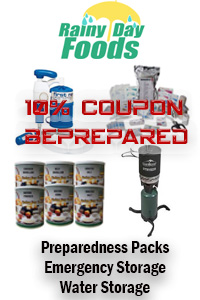By The Maj.
I am a sucker for just about all of the TEOTWAWKI movies and shows when time allows. I enjoy watching both fiction and non-fiction shows for entertainment, gathering new ideas, and/or several “what not to do’s”. I understand that movies never give an accurate portrayal of many things and most “movie things” cannot be replicated in the real world but some of the concepts can be interesting and funny at the same time. Obviously the same can be said for several of the prepping and “reality” shows out there. For most though, there is “One Thing” that always seems to be ignored or passed over is the absolute necessity of / difficulty in acquiring water post-SHTF. Funny to an extent, but next to getting shot, it is the “One Thing” that will probably kill you the quickest when all things have gone wrong with the world.
Yes, I know water is not the sexiest thing to focus on in a movie or show, especially when the zombies are swarming. On the same note, I am positively certain that there will be plenty of dead people post-SHTF (including preppers) that have plenty of remaining ammunition, food, medical supplies, etc. but would have traded every bit of it for a single bottle of potable water before they died of dehydration or a water-borne disease. Think about that and let it sink in for a minute. All this time prepping and that “One Thing” is where I am betting most will fail. Certainly, in most places there is plenty of water to go around and surface water seems to be abundant – TODAY, but is it enough? Most of you reading this probably have a couple of cases of bottled water, maybe some type of filtration system, and a pot to boil water in at a minimum, some have more, some probably have less. It is an age old issue, unbeatable armies throughout history have been decimated and entire cities or towns have vanished because of a lack of water, or a change in the water supply. So, to think post-SHTF will be any different is to only kid yourself.
Before we get into the “how much” question(s), let’s take a look at some of the issues with water. First and foremost, water is bulky and requires quite a bit of room for storage and this bulk takes away from storage for other necessary items (I have yet to meet the prepper with unlimited storage space). It is heavy and not easy to transport in large quantities. Compared to other items in most prepper inventories, it does not have the “long term shelf” life and requires more consistent rotation in order to keep it fresh. On the same note, it is easily contaminated or rendered non-potable. Apparent abundant water sources in today’s world will be useless post-SHTF or require additional steps in purification in order to make them potable – when the electricity goes, so goes the water at the tap, water treatment facilities go down spilling untreated sewage into creeks and rivers, and eventually, the stagnant swimming pools will become a sea of green to name a few. It is these issues and the sheer quantity of water necessary to survive that makes an apparently simple problem to solve one of the more complex issues for a prepper.
How much do you need? Well, to an extent, that is a personal prepping dilemma but most tend to stick in the range of two (2) gallons per person per day as the minimum and this two gallons per day is strictly for consumption (drinking) and cooking (yes, those freeze dried/dehydrated meals you have stored take water to reconstitute). As an individual, this means you will require sixty (60) gallons of potable water in order to survive for ONE MONTH and that one month does not include washing clothes or taking a bath or washing your dishes/utensils or brushing your teeth or…… For a family of four that means a minimum of two hundred and forty (240) gallons of water just to survive the first month post-SHTF. On the annual basis you are looking at 720 gallons for the individual and 2,880 gallons for the family of four. Naturally, that two (2) gallons per day minimum can and will increase depending on an individual’s activity level, weather conditions, and sickness but those are a relative unknown for planning purposes.
Minimum personal hygiene and sanitation requirements add an additional one to two gallons of water per day to your storage requirements. Having this on hand means you can wash your hands, brush your teeth, wash your utensils/pots, and maybe work in a wet rag bath for the problematic areas. Staying clean and having the ability to sanitize cooking utensils will become even more important than ever post-SHTF, so it really cannot be ignored or dismissed in planning for the water it will require. When you move on to more “advanced” personal hygiene and sanitation with the Saturday night bath and once per week clothes washing, you will have to consider a minimum of an additional one gallon per day per person (2.5 gallon shower and 4 gallons clothes washing weekly). Ultimately, this equates to two (2) to three (3) gallons per person per day for personal hygiene and sanitation for planning purposes. Going with the high end, you will need ninety gallons (90) for the individual or three hundred and sixty (360) gallons for the family of four for one month or 1,080 gallons individually / 4,320 gallons for the family annually.
Now, I know what you are thinking. “That is a LOT of water!” “No way consumption will be that high post-SHTF!” Ok, prove me wrong. Water consumption in the U.S., today, averages between 69 and 100 gallons per person DAILY. It is something “we” take for granted and we waste an awful lot. However, the average individual consumption in Africa falls between 10 to 16 gallons per day. The numbers I have used here put water consumption at 5 gallons per person per day, which is low, very low. So, if you want to be realistic, while you sit behind your keyboard reading this, the planning factors actually should get you closer to a minimum of 10 gallons per person per day or 3,650 gallons per person per day annually. Unless of course you think you can “survive” better than those that have been doing so a heck of a lot longer than you?
By The Maj:
Regardless of how you look at it and what factors you want to use for planning purposes, you either have to store a very large quantity of water (2,880 to 14,600 gallons annually for a family of four) AND have a plan in place to rotate it OR store an acceptable quantity AND have a plan in place to acquire the water you will need to survive after your stored assets are depleted. Either option is acceptable and both come with their own unique set of challenges, but the take away point here is planning for long-term water consumption can get pretty complicated and it is more often than not, the “One Thing” that tends to get explained away or overlooked. Your post-SHTF water plan needs to include redundant safe guards and steps to ensure that you have potable water available for you and your family. To many, the easy answer is “I will rely on this” but when “this” fails, what is you plan then? You simply cannot take those chances with water and you need to build your plan to address your needs while ensuring that there are plenty of backups built into the plan to account for a failure in one part or the other.









3 comments
Sad but true. Most of us would die from lack of water or from drinking contaminated water in an extended SHTF situation before we ran out of food or ammo. Most of us can’t store 14,600 gallons of water…just not feasible. However it is very feasible in certain areas to dig a well and in many parts of the U.S. you can find water at surprisingly reasonable levels. If you Google “DIY well drilling” you will see some good websites and videos on YouTube. I hit ground water at 25 feet in my backyard with a DIY rig and had no clue it was that close. YMMV of course each local geography is very different. Still worth looking into for anyone concerned.
Wells are an excellent prep and can be installed easily in some areas, not so much in others. Like you said, it all depends on the geography, water table, and climate where you happen to live or Bugout to. Traditional deep wells require electricity in most cases to get the water out of the ground and shallow wells can be affected significantly by an extended drought but work well with a hand pump.
I am looking at installing a windmill over one of my deep wells to water the livestock today and as a means of still being able to get water from the deep well post SHTF. It will be a significant investment but should be worth it.
Agreed that the importance of water is often underestimated. learning how to properly treat water is one of the most important basic survival skills you can have!